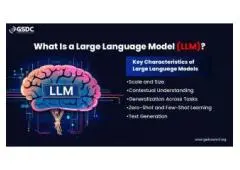Description
In today’s AI-driven world, Large Language Models (LLMs)are transforming how we interact with technology. These advanced systems, built on deep learning architectures, are trained on massive datasets comprising books, websites, and articles. Their ability to understand context and generate human-like text makes them central to innovations in communication, content creation, and automation.
What Are Large Language Models?
LLMs are sophisticated AI systems designed to understand, interpret, and generate human language. Powered by billions of parameters, these models use deep neural networks to identify patterns in text and deliver intelligent responses. To understand their use across industries, a Generative AI Professional Certification can provide valuable insights.
Use Cases of LLMs
LLMs are revolutionizing various domains:
Text Generation: Emails, blogs, and long-form content with human-like fluency.
Summarization: Compressing lengthy documents, news, or reports.
AI Assistants: Natural language support in customer care and internal tools.
Code Generation: Writing, debugging, and translating code.
Sentiment Analysis: Gauging tone and improving brand perception.
Language Translation: Enhancing global reach with multilingual support.
How Do LLMs Work?
LLMs function through complex neural networks that predict text based on learned patterns. When given input, they analyze context and generate relevant output using previously trained data. The more data they're exposed to, the better their performance.
Key Characteristics
Scale & Size: Massive models with billions of parameters.
Contextual Understanding: They maintain coherence across conversations.
Generalization: Perform multiple tasks without retraining.
Zero-/Few-Shot Learning: Adapt to new tasks with minimal input.
Human-like Text Generation: Deliver natural, fluent language for various purposes.
Advantages
LLMs are:
Flexible: Suitable for content, technical writing, and support.
Efficient: Automate tasks and boost productivity.
Contextually Aware: Provide logical, flowing responses.
Adaptable: Quickly learn new tasks with few examples.
Limitations
Despite their strengths, LLMs can:
Generate plausible but inaccurate responses.
Misinterpret cultural or emotional context.
Demand high computational resources.
Reinforce biases found in training data.
Future Outlook
With advancements like ChatGPT, LLMs are reshaping industries. While enhancing productivity, they also raise ethical and employment concerns. Understanding their evolving impact is crucial.
Final Thoughts
LLMs represent a major advancement in AI. To harness their full potential, consider enrolling in a Generative AI Professional Certification to explore their capabilities and applications further.






You must log in or register a new account in order to contact the publisher
Useful information
- Avoid scams by acting locally or paying with PayPal
- Never pay with Western Union, Moneygram or other anonymous payment services
- Don't buy or sell outside of your country. Don't accept cashier cheques from outside your country
- This site is never involved in any transaction, and does not handle payments, shipping, guarantee transactions, provide escrow services, or offer "buyer protection" or "seller certification"








